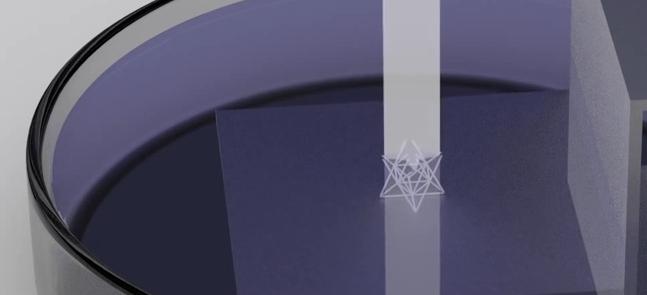The materials engineers at Lawrence Livermore National Laboratory work on the bleeding edge of 3D printing, and they’ve now developed a substance and printer which mixes metal and ceramics with flexible plastics that’s capable of astonishing strength.
“It can hold more than 10,000 times its own weight,” says Chris Spadaccini, a materials engineer at LLNL of the tiny structure. “Our micro-architected materials have properties that are governed by their geometric layout at the microscale, as opposed to chemical composition. We fabricated these materials with projection micro-stereolithography.”
 What we’re describing here are materials which will someday be used in products that require strong, but lightweight, parts such as automobiles and aerospace vehicles. They’re essentially materials with the same weight and density as what are know as aerogels, but they may well have a lasting and wide-ranging list of applications.
What we’re describing here are materials which will someday be used in products that require strong, but lightweight, parts such as automobiles and aerospace vehicles. They’re essentially materials with the same weight and density as what are know as aerogels, but they may well have a lasting and wide-ranging list of applications.
As most lightweight cellular materials exhibit mechanical properties are very likely to bend under any load applied to them, this process uses structural elements to create ultrastiff properties something like three orders of magnitude stronger with their density.
By us ing their additive, micro-manufacturing process, the team at LLNL have rapidly generated materials which feature a set of intricate 3D micro-scale geometries. The process uses a micro-mirror display chip which creates the high-fidelity parts from photosensitive materials.
ing their additive, micro-manufacturing process, the team at LLNL have rapidly generated materials which feature a set of intricate 3D micro-scale geometries. The process uses a micro-mirror display chip which creates the high-fidelity parts from photosensitive materials.
In one project, the team used polymer as a template to fabricate what they call “microlattices” which were coated with a thin film of metal ranging from 200 to 500 nanometers thick. Heat was then used to remove the polymer core of the structure, and that left a hollow metal “strut” which is both ultralight and very strong.
“The key to this ultrahigh stiffness is that all the micro-structural elements in this material are designed to be ‘over constrained’ and do not bend under applied load,” says LLNL Engineer Xiaoyu “Rayne” Zheng.
And the process works with multiple materials, from polymers to metals to ceramics.
In yet another application of the method, the LLNL team repeated the concept with polymer mircolattices, but rather than coat them with metal, ceramics were used to produce a coating around 50 nanometers thick, and the density of that object shows properties like aerogel as well.
“(Aerogel is) among the lightest materials in the world,” Spadaccini said. “Because of its micro-architected layout, (our material) performs with four orders of magnitude higher stiffness than aerogel at a comparable density.”
A third experiment saw the team use a polymer and ceramic mix to build a polymer-ceramic hybrid microlattice. What was left was a fully ceramic material which shows strength and stiffness properties like the other two objects.
The work was completed and published by Spadaccini, Zheng, and MIT professor Nicholas Fang. The lead authors were aided by a joint LLNL-MIT research team which included Todd Weisgraber, Maxim Shusteff, Joshua Deotte, Eric Duoss, Joshua Kuntz, Monika Biener, Julie Jackson, Sergei Kucheyev, Howon Lee, and Qi “Kevin” Ge.

L-R: Eric Duoss, Julie Jackson, Chris Spadaccini, Xiaoyu “Rayne” Zheng, and Todd Weisgraber
The Defense Advanced Research Projects Agency and the Lawrence Livermore Laboratory Directed Research and Development program funded the project.
Materials innovations are driving 3D printing into the future, and this project by the Lawrence Livermore National Laboratory and MIT will ultimately impact manufacturing methods in factory floors and space agencies. Do you know of any research projects impacting 3D printing technology? Let us know in the Strong 3D Printed Microlattices forum thread on 3DPB.com.
Subscribe to Our Email Newsletter
Stay up-to-date on all the latest news from the 3D printing industry and receive information and offers from third party vendors.
You May Also Like
3D Printing Financials: Fathom Struggles in Financial Quicksand During Critical Transition
Facing a year of key transitions and financial pressures, Fathom (Nasdaq: FTHM) has filed its annual report for 2023 with the U.S. Securities and Exchange Commission (SEC). The document outlines...
Latest Earnings Overview for Australian 3D Printing Firms Titomic and AML3D
Australian 3D printing manufacturing firms Titomic (ASX: TTT) and AML3D (ASX: AL3) reported their financial results for the period from July to December 2023, marking the first half of their...
3D Printing Webinar and Event Roundup: April 7, 2024
Webinars and events in the 3D printing industry are picking back up this week! Sea-Air-Space is coming to Maryland, and SAE International is sponsoring a 3D Systems webinar about 3D...
3D Printing Financials: Unpacking Farsoon and BLT’s 2023 Performance
In the Chinese 3D printing industry, two companies, Farsoon (SHA: 688433) and Bright Laser Technologies, or BLT (SHA: 688333), have recently unveiled their full-year earnings for 2023. Farsoon reported increases...































